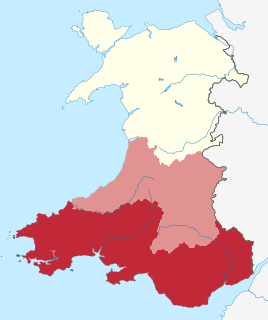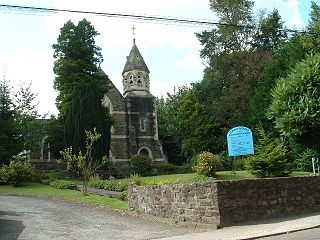Buildings of note
The largest industry in the history of the area was the Wern Tarw Colliery. First opened in 1915 as a drift mine by Meiros Colleries, a deep pit was later added and by 1938 over 400 men were employed at the site. By 1945 the drift and pit, along with workers at the Hafod Seam, employed 700 miners. In 1951, a decision by the National Coal Board to move 87 workers to the nearby Llanharan Colliery, resulted in the first major coalminer's strike since the nationalisation of the industry. The colliery closed in 1964. [3]
A major employer in the community is Rockwool, whose factory and chimney stacks at the site of Wern Tarw dominates the area.
St Paul's church, on the High Street of Heol-y-Cyw, is the largest religious building in the community. Built in 1889, after a local cottage used for services could no longer accommodate the growing congregation, the church was funded by a £50 grant from the Bishop of Llandaff. The church organ, purchased second-hand in 1909 and restored in 1992, is believed to be over 150 years old. [4]

Maesteg is a town and community in Bridgend County Borough, Wales. Maesteg lies at the northernmost end of the Llynfi Valley, close to the border with Neath Port Talbot. In 2011, Maesteg had a population of 20,612. The English translation of Maesteg is 'fair field'.

Bridgend County Borough is a county borough in the south-east of Wales. The county borough has a total population of 139,200 people, and contains the town of Bridgend, after which it is named. Its members of the Senedd are Sarah Murphy MS, representing the Bridgend Constituency, and Huw Irranca-Davies MS representing the Ogmore Constituency, and its members of UK parliament are Jamie Wallis and Chris Elmore.

Pencoed is a urbanised community and town in the county borough of Bridgend, Wales. It straddles the M4 motorway north east of Bridgend and is situated on the Ewenny River. At the 2011 census it had a population of around 9,166.

Woolley Colliery is a village on the border between the Barnsley and Wakefield districts in Yorkshire, England. The village is now in South Yorkshire, while the former colliery was in the Wakefield Rural Ward in West Yorkshire. The village is known locally as Mucky Woolley, as a tribute to its coalmining heritage and to distinguish it from the more affluent village of Woolley two miles away.

South Wales is a loosely defined region of Wales bordered by England to the east and mid Wales to the north. It has a population of around 2.2 million, almost three-quarters of the whole of Wales, including 400,000 in Cardiff, 250,000 in Swansea and 150,000 in Newport. Generally considered to include the historic counties of Glamorgan and Monmouthshire, south Wales extends westwards to include Carmarthenshire and Pembrokeshire. In the western extent, from Swansea westwards, local people would probably recognise that they lived in both south Wales and west Wales. The Brecon Beacons National Park covers about a third of south Wales, containing Pen y Fan, the highest British mountain south of Cadair Idris in Snowdonia.

Tondu is a village in Bridgend County Borough, Wales, located about 3 miles (4.8 km) north of the town of Bridgend, in the community of Ynysawdre.

Heol-y-Cyw is a little village in Bridgend County Borough, Wales, located near Bridgend, in the community of Coychurch Higher. The village, and its surroundings, had a population of 538 in 2011 census.

Nantgarw is a village in the county borough of Rhondda Cynon Taf, Wales, near Cardiff.

Coychurch is a small village that sits between Pencoed and Bridgend in Wales, bordering with Bridgend Industrial Estate, where many residents are employed. It is part of the community of Coychurch Lower.

Gwersyllt is an urban village and community in Wrexham County Borough, Wales.
In 1861 the Llynvi Valley Railway was opened in Glamorganshire, Wales, to convey mineral products to the Bristol Channel at Porthcawl. It adopted an earlier tramroad, the Duffryn Llynvi and Porthcawl Railway. The Llynvi and Ogmore Railway was opened in 1865, and the two companies amalgamated to form the Llynvi and Ogmore Railway in 1866. At first Porthcawl harbour was an important destination for onward transport, but this soon declined.

Llanharan is a village and community in the county borough of Rhondda Cynon Taf, Wales. As a community Llanharan takes in the neighbouring settlements of Bryncae, Brynna, Llanilid, Peterston-super-Montem and Ynysmaerdy. Llanharan thrived during the British Industrial Revolution, with several tin and coal mines in the location providing employment to the town's residents. With the decline of heavy industry in the South Wales Coalfield, Llanharan has been in economic decline, though its proximity to the M4 motorway offers its residents easy commutable access to most of South Wales.

Caerau is an electoral ward, village and former mining village in South Wales, Wales, located approximately 2 miles north of Maesteg in the Llynfi Valley, and is part of the Bridgend County Borough. Caerau, surrounded by mountainous terrain and forestry, is one of the border points between Bridgend County Borough and Neath Port Talbot County Borough, bordered to the north by Croeserw and Cymmer, Neath Port Talbot. Caerau, borders Dyffryn and Spelter to the south in Nantyffyllon, Maesteg, Bridgend.

Chisnall Hall Colliery was a coal mine in Coppull in Lancashire, England. It was the largest coal mine on the Lancashire Coalfield north of Wigan. The colliery on Coppull Moor was owned by Pearson and Knowles Coal and Iron Company in 1896 when it employed 135 underground and 48 surface workers. The colliery appeared on maps in 1908 as a coal mine with two shafts and railway sidings connecting its 1.5-mile mineral railway to the London and North Western Railway's Wigan–Preston main line. In 1930, Pearson & Knowles merged with the Wigan Coal and Iron Company and others and their collieries became the property of the Wigan Coal Corporation. More than 1,000 people were employed there in 1933 and more than 300,000 tonnes of coal were produced annually.

Coal mining in the United Kingdom dates back to Roman times and occurred in many different parts of the country. Britain's coalfields are associated with Northumberland and Durham, North and South Wales, Yorkshire, the Scottish Central Belt, Lancashire, Cumbria, the East and West Midlands and Kent. After 1972, coal mining quickly collapsed and had practically disappeared by the 21st century. The consumption of coal – mostly for electricity – fell from 157 million tonnes in 1970 to 18 million tonnes in 2016, of which 77% was imported from Colombia, Russia, and the United States. Employment in coal mines fell from a peak of 1,191,000 in 1920 to 695,000 in 1956, 247,000 in 1976, 44,000 in 1993, and to 2,000 in 2015.

The Lancashire Coalfield in North West England was an important British coalfield. Its coal seams were formed from the vegetation of tropical swampy forests in the Carboniferous period over 300 million years ago.
The Tarenni Colliery and its associated workings, are a series of coal mines and pits located between the villages of Godre'r Graig and Cilybebyll located in the valley of the River Tawe, in Neath Port Talbot county borough, South Wales.

Coychurch Lower is a community in Bridgend County Borough, South Wales. Along with the communities of Brackla and Bridgend, it makes up the town of Bridgend. Coychurch Lower is the eastern district of Bridgend, and takes in the village of Coychurch and the area known as Waterton. Traffic leaving the M4 Motorway for Bridgend at Junction 35 travels through Coychurch Lower along the A473 road, passing through an area of business parks and out-of town shopping zones, which takes up the majority of the western half of the community. The population of Coychurch Lower at the 2001 census was 1206, increasing to 1,365 at the 2011 census.
Bwllfa Colliery was a coal mine located in the Dare valley near Cwmdare in Rhondda Cynon Taf, South Wales. It operated from 1856 to 1957, remaining open as a ventilation shaft for Mardy Colliery until 1989.
















